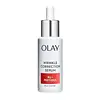What's inside
What's inside
 Key Ingredients
Key Ingredients

 Benefits
Benefits

 Concerns
Concerns

No concerns
 Ingredients Side-by-side
Ingredients Side-by-side

Water
Skin ConditioningCaprylic/Capric/Myristic/Stearic Triglyceride
EmollientPetrolatum
EmollientHexyldecyl Stearate
EmollientButylene Glycol
HumectantDimethicone
EmollientGlycereth-26
HumectantPEG-100 Stearate
Cetearyl Alcohol
EmollientGlyceryl Stearate
EmollientPropanediol
SolventNarcissus Tazetta Bulb Extract
AstringentCucumis Sativus Fruit Extract
EmollientMimosa Tenuiflora Bark Extract
Skin ProtectingHordeum Vulgare Extract
EmollientCucumis Melo Fruit Extract
Skin ConditioningPersea Gratissima Oil
Skin ConditioningLactis Proteinum
Skin ConditioningCaffeine
Skin ConditioningThermus Thermophillus Ferment
Skin ConditioningAlgae Extract
EmollientLaminaria Digitata Extract
Skin ProtectingArtemia Extract
Skin ConditioningAcetyl Hexapeptide-8
HumectantPolygonum Cuspidatum Root Extract
AntioxidantErgothioneine
AntioxidantTrifluoroacetyl Tripeptide-2
Skin ConditioningTrehalose
HumectantSorbitol
HumectantGlycerin
HumectantDecarboxy Carnosine Hcl
Skin ConditioningCholesterol
EmollientIsohexadecane
EmollientAcetyl Glucosamine
Skin ConditioningMyristyl Myristate
EmollientCetearyl Glucoside
EmulsifyingTetradecyl Aminobutyroylvalylaminobutyric Urea Trifluoroacetate
Skin ConditioningPropylene Glycol Dicaprylate
EmollientAminopropyl Ascorbyl Phosphate
AntioxidantCaprylyl Glycol
EmollientAcrylates/C10-30 Alkyl Acrylate Crosspolymer
Emulsion StabilisingCaprylic/Capric Triglyceride
MaskingTocopheryl Acetate
AntioxidantLinoleic Acid
CleansingPolysorbate 80
EmulsifyingYeast Extract
Skin ConditioningPropylene Glycol Dicaprate
EmollientZinc PCA
HumectantHelianthus Annuus Seedcake
AbrasiveHexylene Glycol
EmulsifyingAcrylamide/Sodium Acryloyldimethyltaurate Copolymer
Emulsion StabilisingSodium Hyaluronate
HumectantMyristyl Alcohol
EmollientTromethamine
BufferingStearic Acid
CleansingPotassium Sulfate
Pentaerythrityl Tetra-Di-T-Butyl Hydroxyhydrocinnamate
AntioxidantCitric Acid
BufferingMaltodextrin
AbsorbentAluminum Hydroxide
EmollientParfum
MaskingPotassium Sorbate
PreservativeDextran
Disodium EDTA
BHT
AntioxidantPhenoxyethanol
PreservativeCI 42090
Cosmetic ColorantCI 17200
Cosmetic ColorantCI 77891
Cosmetic ColorantWater, Caprylic/Capric/Myristic/Stearic Triglyceride, Petrolatum, Hexyldecyl Stearate, Butylene Glycol, Dimethicone, Glycereth-26, PEG-100 Stearate, Cetearyl Alcohol, Glyceryl Stearate, Propanediol, Narcissus Tazetta Bulb Extract, Cucumis Sativus Fruit Extract, Mimosa Tenuiflora Bark Extract, Hordeum Vulgare Extract, Cucumis Melo Fruit Extract, Persea Gratissima Oil, Lactis Proteinum, Caffeine, Thermus Thermophillus Ferment, Algae Extract, Laminaria Digitata Extract, Artemia Extract, Acetyl Hexapeptide-8, Polygonum Cuspidatum Root Extract, Ergothioneine, Trifluoroacetyl Tripeptide-2, Trehalose, Sorbitol, Glycerin, Decarboxy Carnosine Hcl, Cholesterol, Isohexadecane, Acetyl Glucosamine, Myristyl Myristate, Cetearyl Glucoside, Tetradecyl Aminobutyroylvalylaminobutyric Urea Trifluoroacetate, Propylene Glycol Dicaprylate, Aminopropyl Ascorbyl Phosphate, Caprylyl Glycol, Acrylates/C10-30 Alkyl Acrylate Crosspolymer, Caprylic/Capric Triglyceride, Tocopheryl Acetate, Linoleic Acid, Polysorbate 80, Yeast Extract, Propylene Glycol Dicaprate, Zinc PCA, Helianthus Annuus Seedcake, Hexylene Glycol, Acrylamide/Sodium Acryloyldimethyltaurate Copolymer, Sodium Hyaluronate, Myristyl Alcohol, Tromethamine, Stearic Acid, Potassium Sulfate, Pentaerythrityl Tetra-Di-T-Butyl Hydroxyhydrocinnamate, Citric Acid, Maltodextrin, Aluminum Hydroxide, Parfum, Potassium Sorbate, Dextran, Disodium EDTA, BHT, Phenoxyethanol, CI 42090, CI 17200, CI 77891
Water
Skin ConditioningDimethicone
EmollientGlycerin
HumectantNiacinamide
SmoothingButylene Glycol
HumectantPalmitoyl Pentapeptide-4
Skin ConditioningPalmitoyl Dipeptide-7
Skin ConditioningPanthenol
Skin ConditioningHydroxyacetophenone
AntioxidantDimethiconol
EmollientPolysorbate 20
EmulsifyingDisodium EDTA
Dimethicone Crosspolymer
Emulsion StabilisingCarbomer
Emulsion StabilisingAcrylates/C10-30 Alkyl Acrylate Crosspolymer
Emulsion StabilisingAminomethyl Propanol
BufferingPhenoxyethanol
PreservativeWater, Dimethicone, Glycerin, Niacinamide, Butylene Glycol, Palmitoyl Pentapeptide-4, Palmitoyl Dipeptide-7, Panthenol, Hydroxyacetophenone, Dimethiconol, Polysorbate 20, Disodium EDTA, Dimethicone Crosspolymer, Carbomer, Acrylates/C10-30 Alkyl Acrylate Crosspolymer, Aminomethyl Propanol, Phenoxyethanol
Ingredients Explained
These ingredients are found in both products.
Ingredients higher up in an ingredient list are typically present in a larger amount.
Acrylates/C10-30 Alkyl Acrylate Crosspolymer is a synthetic polymer. It is used to thicken and improve the texture of products. Due to its properties, it can prevent water and oil ingredients from separating.
Butylene Glycol (or BG) is used within cosmetic products for a few different reasons:
Overall, Butylene Glycol is a safe and well-rounded ingredient that works well with other ingredients.
Though this ingredient works well with most skin types, some people with sensitive skin may experience a reaction such as allergic rashes, closed comedones, or itchiness.
Learn more about Butylene GlycolDimethicone is a type of synthetic silicone created from natural materials such as quartz.
What it does:
Dimethicone comes in different viscosities:
Depending on the viscosity, dimethicone has different properties.
Ingredients lists don't always show which type is used, so we recommend reaching out to the brand if you have questions about the viscosity.
This ingredient is unlikely to cause irritation because it does not get absorbed into skin. However, people with silicone allergies should be careful about using this ingredient.
Note: Dimethicone may contribute to pilling. This is because it is not oil or water soluble, so pilling may occur when layered with products. When mixed with heavy oils in a formula, the outcome is also quite greasy.
Learn more about DimethiconeDisodium EDTA plays a role in making products more stable by aiding other preservatives.
It is a chelating agent, meaning it neutralizes metal ions that may be found in a product.
Disodium EDTA is a salt of edetic acid and is found to be safe in cosmetic ingredients.
Learn more about Disodium EDTAGlycerin is already naturally found in your skin. It helps moisturize and protect your skin.
A study from 2016 found glycerin to be more effective as a humectant than AHAs and hyaluronic acid.
As a humectant, it helps the skin stay hydrated by pulling moisture to your skin. The low molecular weight of glycerin allows it to pull moisture into the deeper layers of your skin.
Hydrated skin improves your skin barrier; Your skin barrier helps protect against irritants and bacteria.
Glycerin has also been found to have antimicrobial and antiviral properties. Due to these properties, glycerin is often used in wound and burn treatments.
In cosmetics, glycerin is usually derived from plants such as soybean or palm. However, it can also be sourced from animals, such as tallow or animal fat.
This ingredient is organic, colorless, odorless, and non-toxic.
Glycerin is the name for this ingredient in American English. British English uses Glycerol/Glycerine.
Learn more about GlycerinPhenoxyethanol is a preservative that has germicide, antimicrobial, and aromatic properties. Studies show that phenoxyethanol can prevent microbial growth. By itself, it has a scent that is similar to that of a rose.
It's often used in formulations along with Caprylyl Glycol to preserve the shelf life of products.
Water. It's the most common cosmetic ingredient of all. You'll usually see it at the top of ingredient lists, meaning that it makes up the largest part of the product.
So why is it so popular? Water most often acts as a solvent - this means that it helps dissolve other ingredients into the formulation.
You'll also recognize water as that liquid we all need to stay alive. If you see this, drink a glass of water. Stay hydrated!
Learn more about Water